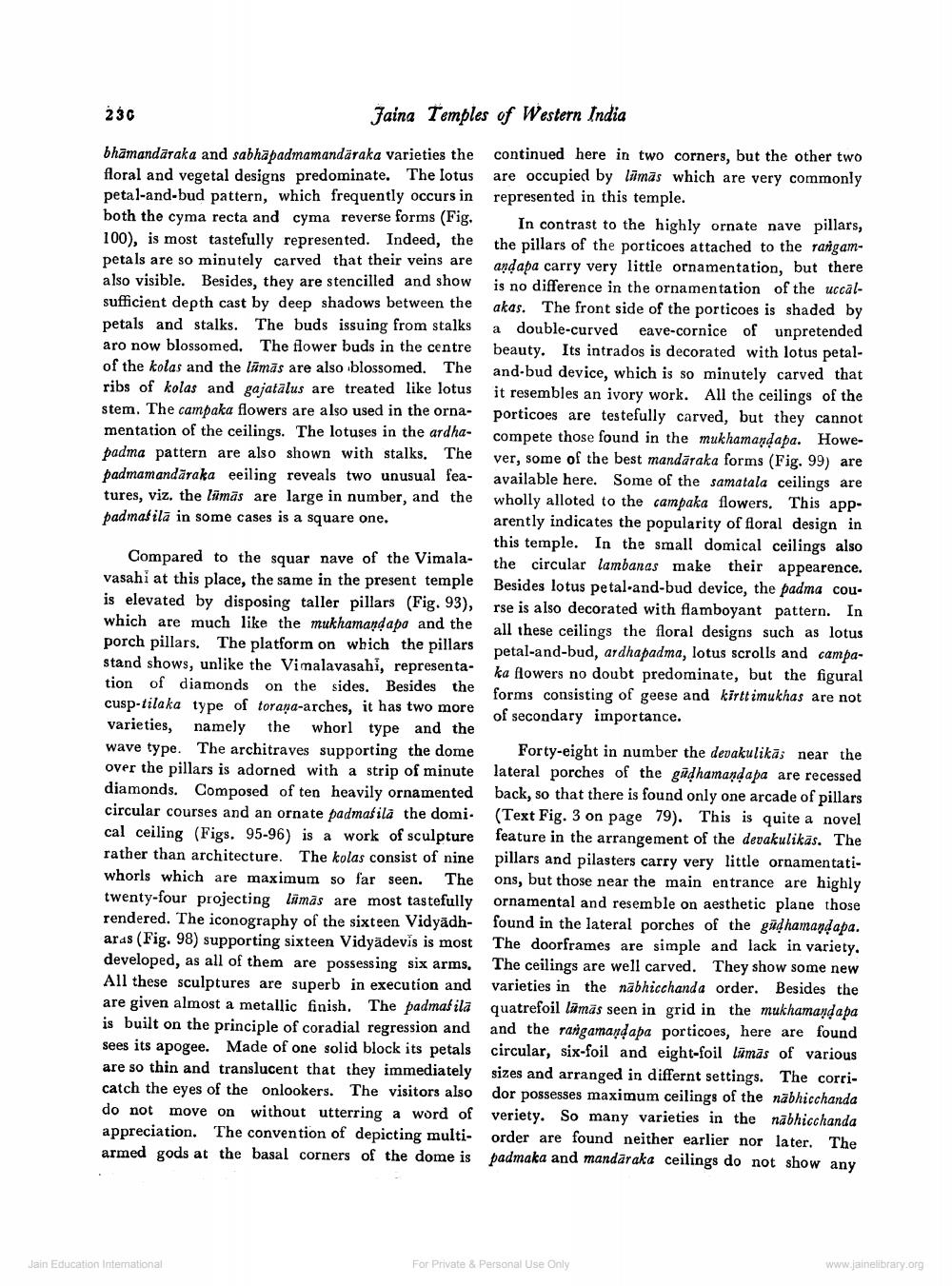________________
23C
Faina Temples of Western India bhāmandāraka and sabhapadmamandaraka varieties the continued here in two corners, but the other two floral and vegetal designs predominate. The lotus are occupied by lūmas which are very commonly petal-and-bud pattern, which frequently occurs in represented in this temple. both the cyma recta and cyma reverse forms (Fig. In contrast to the highly ornate nave pillars, 100), is most tastefully represented. Indeed, the the pillars of the porticoes attached to the rangampetals are so minutely carved that their veins are andaba carry very little ornamentation, but there also visible. Besides, they are stencilled and show is no difference in the ornamentation of the uccalsufficient depth cast by deep shadows between the akas. The front side of the porticoes is shaded by petals and stalks. The buds issuing from stalks a double-curved eave-cornice of unpretended aro now blossomed. The flower buds in the centre beauty. Its intrados is decorated with lotus petalof the kolas and the lāmās are also blossomed. The and-bud device, which is so minutely carved that ribs of kolas and gajatalus are treated like lotus it resembles an ivory work. All the ceilings of the stem. The campaka flowers are also used in the orna- Porticoes are testefully carved, but they cannot mentation of the ceilings. The lotuses in the ardha- compete those found in the mukhamandapa. Howepadma pattern are also shown with stalks. The ver, some of the best mandāraka forms (Fig. 99) are padmamandāraka eeiling reveals two unusual fea- available here. Some of the samatala ceilings are tures, viz. the lāmās are large in number, and the wholly alloted to the campaka flowers. This apppadmašila in some cases is a square one.
arently indicates the popularity of floral design in
this temple. In the small domical ceilings also Compared to the squar nave of the Vimala- the circular lambanas make their appearence. vasahi at this place, the same in the present temple Besides lotus petal-and-bud device, the padma cou. is elevated by disposing taller pillars (Fig. 93), rse is also decorated with flamboyant pattern. In which are much like the mukhamandapo and the all these ceilings the floral designs such as lotus porch pillars. The platform on which the pillars Detal-and-bud, ardhapadma, lotus scrolls and campastand shows, unlike the Vimalavasahi, representa- ka flowers no doubt predominate, but the figural tion of diamonds on the sides. Besides the
forms consisting of geese and kirttimukhas are not cusp-tilaka type of torama-arches, it has two more of secon
of secondary importance. varieties, namely the whorl type and the wave type. The architraves supporting the dome Forty-eight in number the devakulikās near the over the pillars is adorned with a strip of minute lateral porches of the güdhamandapa are recessed diamonds. Composed of ten heavily ornamented back, so that there is found only one arcade of pillars circular courses and an ornate padmašila the domi. (Text Fig. 3 on page 79). This is quite a novel cal ceiling (Figs. 95-96) is a work of sculpture feature in the arrangement of the devakulikās. The rather than architecture. The kolas consist of nine pillars and pilasters carry very little ornamentatiwhorls which are maximum so far seen. The ons, but those near the main entrance are highly twenty-four projecting lämās are most tastefully ornamental and resemble on aesthetic plane those rendered. The iconography of the sixteen Vidyadh- found in the lateral porches of the güdhamandapa. aras (Fig. 98) supporting sixteen Vidyadevis is most The doorframes are simple and lack in variety. developed, as all of them are possessing six arms. The ceilings are well carved. They show some new All these sculptures are superb in execution and varieties in the nābhicchanda order. Besides the are given almost a metallic finish. The padmašila quatrefoil lūmās seen in grid in the mukhamandapa is built on the principle of coradial regression and and the rangamandapa porticoes, here are found sees its apogee. Made of one solid block its petals circular, six-foil and eight-foil lämäs of various are so thin and translucent that they immediately sizes and arranged in differnt settings. The corricatch the eyes of the onlookers. The visitors also dor possesses maximum ceilings of the näbhicchanda do not move on without utterring a word of veriety. So many varieties in the nabhicchanda appreciation. The convention of depicting multi-order are found neither earlier nor later. The armed gods at the basal corners of the dome ispadmaka and mandaraka ceilings do not show any
For Private & Personal Use Only
Jain Education International
www.jainelibrary.org




